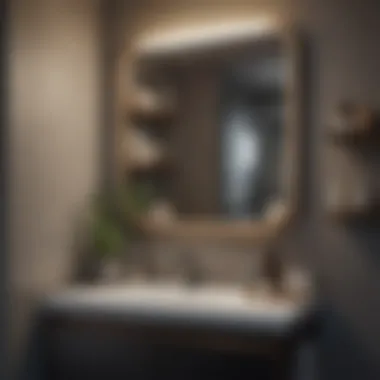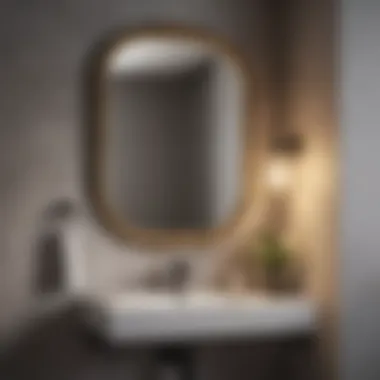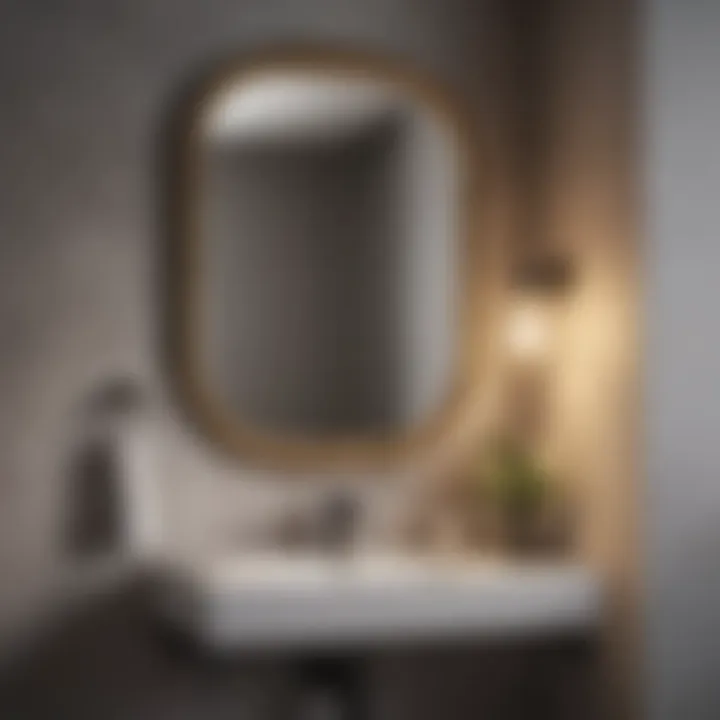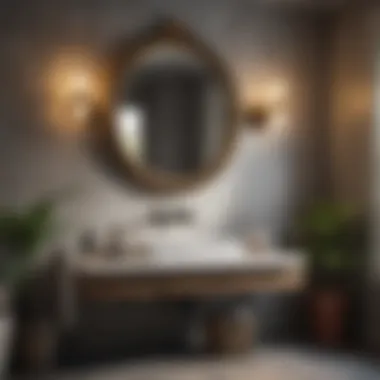Smart Decorating Tips for Small Bathrooms


Intro
Revamping a small bathroom is often seen as a daunting task, but with the right strategies, it can be a delightful endeavor. Small spaces have their own charm and potential, and all it takes is a little creativity to transform them into functional yet stylish sanctuaries. This section will guide you through a couple of inspiring ideas that could serve as the backbone for your redesign.
The essence of a well-decorated bathroom lies in its ability to balance aesthetics with practicality. As we explore trending styles and color palettes, it will become clearer how these elements can enhance the overall vibe and utility of the space.
Design Inspirations
Trending Styles
When thinking about style, it’s important to remember that trends shift like the wind. However, there are a few styles that have stood the test of time, particularly for small bathrooms:
- Scandinavian Minimalism: This style is all about simplicity and functionality. White walls, natural light, and wood accents can make your small space feel more open. A few houseplants can bring life without crowding.
- Rustic Charm: Using reclaimed wood and vintage items can create a cozy atmosphere. Consider adding a wooden sink or vintage mirror to give your bathroom that warm, inviting feel.
To transform your bathroom into a personal oasis, choose a style that reflects your personality.
Color Palettes
Colors play a pivotal role in shaping the perception of space. In small bathrooms, the right color scheme can lighten up the area and provide an illusion of more room.
- Light Neutrals: Shades like soft beige or pale grey can reflect light, making the space feel expansive. These colors serve as a blank canvas, allowing you to play with decor and accessories.
- Bold Accents: While general tones should be light, adding rich colors, like navy blue or emerald green, as accents—think towels, soap dispensers, or even a feature wall—can create depth.
- Monochromatic Schemes: These can be strikingly effective. Using varying shades of the same hue maintains cohesion and elegance, contributing to a sleek appearance.
Product Recommendations
Bath Accessories
Choosing the right accessories can elevate your bathroom setting. Here are some suggestions:
- Floating Shelves: They provide storage without consuming floor space and add an airy feel.
- Compact Storage Solutions: Baskets can keep toiletries organized and are aesthetically pleasing.
- Functional Lighting: Wall sconces or LED strips can brighten the room without taking up valuable space.
Bedroom Essentials
When it comes to essentials, consider items that bring both functionality and comfort:
- Quality Towels: Soft, luxurious towels are not only functional but also elevate the overall aesthetic.
- Mirrors: A large mirror creates depth. Mirrors can also be framed to enhance style aesthetics.
- Natural Elements: Adding plants or bamboo accents can bring some freshness into a small bathroom, making it feel lively and inviting.
In summary, transforming a small bathroom requires a thoughtful approach that blends style and functionality seamlessly. Whether it’s through trending designs or carefully selected color palettes, the key is to enrich the space while retaining its practical use.
Understanding Small Bathroom Challenges
Transforming a small bathroom can be an intricate dance between creativity and functionality. From the outset, it becomes essential to grasp the unique hurdles these compact spaces present. This understanding not only informs design choices but also helps to maximize both visual appeal and practicality. A small bathroom might not seem like a high-stakes environment, but for daily routines, it plays a significant role in our lives.
The Importance of Space Perception
In the context of small bathrooms, space perception is everything. It dictates how we interact with the room and ultimately shapes our user experience. A cleverly designed space can trick the eye into believing it is more expansive than it truly is. Keeping this perceptual aspect in mind can transform a cramped area into an inviting retreat.
Using lighter colors on walls and floors, for example, can create an illusion of airiness. You might say that a splash of soft pastel or a crisp white can go a long way. Also, incorporating various textures, such as a glossy tile or a smooth countertop, can play with light and enhance the sense of space. Reflection also plays a pivotal role here; materials that bounce light, such as mirrors or glossy finishes, are game changers.
To enrich space perception further, opt for strategically placed lighting. Having a mix of ambient, task, and accent lighting can brighten up shadowy corners, making the room feel more open. Always remember, how people perceive space can alter not just aesthetics but also functionality, transforming even the smallest of quarters into a well-organized haven.
Common Limitations in Small Bathrooms
Navigating a small bathroom comes with its share of limitations that can frustrate even the most seasoned decorator. Here are a few challenges that anyone taking on this task needs to keep in mind:
- Limited Square Footage: Often, the most glaring issue is simply not enough room. Every inch counts, and it becomes crucial to prioritize which elements are necessary and which can be sacrificed.
- Built-In Fixtures: Fixtures like bathtubs, sinks, and toilets can occupy significant space. They need to be chosen carefully to ensure that they fit comfortably without overwhelming the room. Sometimes, opting for a pedestal sink instead of a bulky vanity can make a world of difference.
- Storage Constraints: Small bathrooms usually offer scant storage options. This lack can complicate organization, necessitating creative solutions to keep personal items within reach but out of sight.
- Accessibility Challenges: A cramped layout can hinder movement, making it a juggling act to navigate around. Ensuring that the space remains accessible, even while being stylish, is essential.
"Designing for small spaces doesn’t just mean making do; it’s about optimizing every last square inch to create a true sense of home."
Considering these limitations is a cornerstone for crafting a functional small bathroom. Ultimately, the key lies in viewing challenges not as deterrents, but as invitations to innovate. Knowing the common pitfalls allows homeowners and decorators alike to devise specific strategies, ultimately resulting in a space that feels customized and personal. The journey of transforming a small bathroom begins with awareness, leading to well-informed decisions that echo throughout the design process.
Initial Considerations for Decoration
When it comes to decorating small bathrooms, laying a solid groundwork through initial considerations is paramount. These early steps set the stage for a stylish and functional space that reflects your personal style while addressing the limitations inherent in smaller settings. Pinpointing what matters most in your renovation journey can significantly influence the overall outcome.
Defining Your Style Preferences
Before diving into the nitty-gritty of decor, it's key to know what vibe you want to convey. Are you leaning towards modern minimalism, rustic charm, or maybe a vibrant bohemian flair?
Having clear stylistic preferences helps narrow down choices and avoids the dreaded decision paralysis that often strikes in these situations. Here are some pointers:
- Mood Boards: Create a mood board using swatches, pictures, and materials that inspire you. This visual representation can be as straightforward as a collage on a corkboard or a digital collection on platforms like Pinterest.
- Explore Trends: While personal style takes precedence, staying informed about current trends can provide fresh ideas. For example, the recent popularity of matte black fixtures might intrigue you or the timeless elegance of white subway tiles could fit perfectly.
- Balance and Aesthetics: Keep in mind that all elements don’t need to be from the same school of thought. Contrasting styles, when executed well, can bring character and intrigue. Mixing vintage items with contemporary fittings can create a sense of layered history.
Creating a Functional Layout


Once you have your style preferences locked in, the next step involves crafting a functional layout that maximizes every square inch of your bathroom. After all, style is useless if the space doesn't serve your day-to-day needs efficiently. Consider the following aspects:
- Flow of Movement: Ensure that the arrangement allows for smooth movement. Can one person use the toilet while another is washing their hands? The layout must facilitate such interactions without bumping heads.
- Zoning: Divide the bathroom into zones for specific tasks—like a grooming area, shower section, or storage nook. This can help in organizing all your essentials neatly.
- Prioritize Essentials: Think about what items you truly need on hand. Is it a deep soaker tub or a simple shower? The choice between these fixtures can significantly impact your spatial arrangement.
- Function Over Form: While aesthetics are important, never lose sight of practical functionality. For instance, floating vanities can provide storage while visually enlarging the space.
- Seek Professional Input: If the task feels daunting, consider consulting with a designer. A professional can help streamline the process, ensuring that both functionality and style coalesce seamlessly.
"The difference between a space that feels cramped and one that feels cohesive often lies in its initial layout and clarity of purpose."
The initial considerations not only set the tone for your decoration process but also ensure that you're creating a bathroom that is uniquely yours—both beautiful and functional. Proper consideration of style and layout paves the way for a transformation that’s not just skin-deep but resonates with your lifestyle and needs.
Color Schemes and Their Impact
When it comes to small bathrooms, the choice of color schemes plays a pivotal role in not only aesthetics but also the overall perception of space. Colors have an undeniable influence on moods and feelings, and in a compact area like a bathroom, they can create an illusion of openness or coziness. Thus, understanding how different colors affect space can help homeowners craft a bathroom that feels larger and more inviting.
Light colors, for instance, are often the backbone of effective small bathroom decoration strategies. They reflect light, which can open up tight quarters, making the space feel expansive. However, it’s not just about slapping on a coat of white paint; it’s about creating warmth and personality that aligns with one’s style.
Choosing Light Colors to Enhance Space
Using light colors in a small bathroom can yield remarkable results. Shades like soft whites, pale blues, and light grays create an airy atmosphere, which tricks the eye into perceiving more volume. Imagine stepping into a bathroom dressed in muted pastels or creamy hues; it’s as if the walls recede, allowing the space to breathe.
Here are a few key points to consider when selecting light colors:
- Reflective Surfaces: Glossy finishes on walls, cabinets, and tiles lend a reflective quality that can amplify light bounce.
- Continuous Color Flow: Maintaining a similar shade on the walls and ceiling prevents visual interruption, creating a seamless look.
- Natural Light Utilization: Take advantage of any natural light sources. Light colors will work harmoniously to enhance this effect.
On top of that, introducing materials that play well with lighter tones, such as white marble or light wood, can elevate the overall aesthetic. The goal here is to foster an environment that feels open and welcoming.
Incorporating Accent Colors Wisely
Once the foundation of light colors is set, you can introduce accent colors to inject personality and vibrancy. While it might be tempting to go big with dark colors, judicious use of accents can create focal points without overwhelming the limited carpet area.
- Consider Small Sections: Use accent colors on smaller features like a backsplash, decorative towels, or even a shower curtain. This way, you avoid making the space feel smaller without sacrificing style.
- Harmonize with Nature: Shades of green and earth tones often work wonders, making the bathroom feel more connected to nature without sacrificing brightness.
- Balance is Key: Strike a balance between light and dark. For instance, light walls paired with an accent wall in a deeper shade can highlight design elements and details, making them stand out.
"Choose colors that feed your spirit. Your bathroom should reflect your personality while promoting a soothing environment."
In summation, color schemes are not merely aesthetic choices but are vital components in how small spaces are experienced. By starting with a base of light colors and skillfully integrating accents, you can construct a sophisticated small bathroom that feels expansive, inviting, and uniquely yours.
Maximizing Storage Solutions
In the realm of small bathrooms, storage isn't just a luxury—it's a necessity. The limited square footage presents unique challenges that demand innovative solutions. By focusing on maximizing storage, homeowners can create a more organized and functional space. This not only declutters the bathroom but also enhances its visual appeal, making it feel more inviting and comfortable.
Utilizing Vertical Space Efficiently
When dealing with tight spaces, one of the trickest tricks up your sleeve is utilizing vertical space. High ceilings are often an underutilized feature in many small bathrooms. Take advantage of that height! Install tall cabinets or shelves that extend towards the ceiling. This method creates extra storage without taking up precious floor space.
Consider adding floating shelves above the toilet or along the walls. Not only do they provide practical storage for items like towels and toiletries, but they can also serve as decorative features. Stack books, candles, or artful containers to add personality to your bathroom. Moreover, height not only draws the eye upwards, creating the illusion of a larger space but can also be a stylish statement on its own.
"Vertical space is the hidden gem in small bathroom design. Use it wisely, and you’ll unlock a world of storage options!"
Integrated Storage Options
Think beyond traditional cabinetry when strategizing for storage. Integrated storage options can be game-changers in small bathrooms. A clever way to add storage is through fixtures themselves. For instance, vanities with built-in drawers can hold products while maintaining a tidy appearance. Choose a sink with storage shelves underneath to maximize space utilization.
Consider installing recessed shelving in the walls to store items efficiently. This hidden storage keeps everyday essentials close at hand without adding bulk to the room.
Another approach is to use multi-functional furniture. A bench that doubles as a storage trunk or a laundry basket that holds towels can serve dual purposes. These thoughtful additions can convert an ordinary bathroom into a well-organized sanctuary, allowing homeowners to store ample items while keeping the space looking fresh and serene.
Using integrated storage options doesn't merely clean up the look—it can transform how you interact with the space, making your daily routine feel less cluttered and more serene.
Selecting the Right Fixtures
When it comes to transforming a small bathroom, the importance of choosing the right fixtures cannot be overstated. Fixtures play a crucial role in defining both functionality and aesthetics of the space. Each element, from toilets to sinks and showers, needs to be selected thoughtfully to ensure that it complements the overall design while maximizing utility.
One of the main benefits of selecting apt fixtures is space optimization. For instance, plumbing can take up quite a bit of room when not designed wisely. Opting for compact configurations helps prevent the cramped feel that often accompanies smaller bathrooms. Additionally, the right fixtures can significantly improve the bathroom experience, making it more enjoyable to use.
Space-Efficient Toilets and Sinks
Space-efficient toilets and sinks are game changers in small bathrooms. Standard models often occupy too much space, so looking for slimline or wall-mounted options can make a world of difference. These types usually offer the same functionality but with a reduced footprint. Here are some things to consider:
- Compact Designs: Toilets that are designed for small bathrooms often have a smaller bowl and a lower profile. Some models even come with hidden tanks, further freeing up valuable space.
- Sink Selection: Pedestal sinks or vessel sinks that sit above cabinetry can create an illusion of space. They are stylish and make cleaning much easier compared to heavier fixtures.
- Multiple Functionality: Dual-flush toilets not only save water but also provide flexibility for different needs, making them ideal for any household. This feature is environmentally friendly, and can be an appealing aspect for eco-conscious homeowners.
Investing in space-efficient toilets and sinks can drastically enhance the comfort and usability of a small bathroom.
Shower Designs for Small Spaces
Shower designs can either constrict or open up a small bathroom. A well-selected shower can create an inviting focal point without overwhelming the area. Consider these options:
- Corner Showers: Utilizing an unused corner can effectively maximize floor space. These designs not only add an appealing aesthetic but also keep the bathroom uncluttered.
- Glass Shower Doors: Replacing opaque doors with frameless glass panels helps to create an uninterrupted flow, making the room feel larger.
- Shower Tubs: For those who enjoy a soak, a shower-tub combo can be the way to go. There are models designed specifically for small spaces, allowing for a luxurious bathing experience without sacrificing storage or movement.


Adopting these shower designs won't just spotlight your creative flair; it also pragmatically addresses the need for an efficient bathroom layout. Utilizing clever solutions for shower installations can lead to an environment that is both functional and visually appealing.
"The right fixtures can transform not just the look but the functionality of your small bathroom, making it a pleasant space to start and end your day."
Incorporating Stylish Accessories
When it comes to small bathrooms, accessories can make all the difference. These elements not only serve functional purposes, but they also add personality and character. Accessories should be selected carefully to blend functionality with style.
Accessories can elevate the bathroom experience, transforming a merely utilitarian space into a personal retreat. An ornate mirror, decorative soap dispensers, or a quirky bath mat can inject a unique flair into the room.
Moreover, stylish accessories can cleverly disguise limitations within the space. For example, colorful towels can draw attention away from less appealing fixtures, and well-chosen artwork can create a visual focus that adds depth to the walls. In such a compact area, the right accessories also enhance the perception of space, making everything feel more balanced.
When selecting these items, consider colors, textures, and overall themes. Consistency across designs helps in creating a cohesive look rather than a disorganized array of random items. Furthermore, regularly updating these fashionable pieces, like switching out towels per season, keeps the space fresh, allowing for a change without significant renovations.
"In a small bathroom, every accessory tells a story; select pieces that resonate with you and your preferences."
Choosing Towels and Mats that Complement
Towels and mats are essential accessories that offer both functionality and style. Choosing them with care can significantly enhance your bathroom's aesthetic appeal.
When it comes to towels, opt for colors that harmonize with your overall decor. Neutral shades, such as soft beige or pale gray, often blend well and create a calming environment. Alternatively, vibrant colors can add a pop of excitement, capturing attention. In terms of texture, high-quality materials like cotton provide a luxurious feel while promoting quick-drying properties, an essential factor in small spaces.
As for bath mats, they should not only be visually appealing but also practical. A rug that is too large may overwhelm the space, while one that is too small may feel inadequate. Look for mats that are anti-slip to ensure safety in wet environments. Great choices include natural fibers or machine-washable options to simplify maintenance and improve durability.
Storage Baskets and Organizers
The right storage solutions can truly transform a small bathroom from chaotic to organized. Stylish storage baskets and organizers provide essential functionality while also introducing an aesthetics boost.
Opt for coordinating baskets made from materials such as wicker or fabric. These choices can add warmth and texture, making your bathroom feel more inviting. Place them on shelves, under sinks, or in cabinets, tailored to your specific storage needs. Additionally, clear containers can be handy for smaller items, providing visibility and easy access while maintaining a neat appearance.
When choosing organizers, consider tiered shelving units. These not only maximize vertical space but also draw the eye upward, creating an illusion of a roomier environment.
In summary, the careful selection of stylish accessories, towels, and organizers can transform small bathrooms significantly. Integrate personality and functionality, ensuring every element resonates with your unique style while contributing to an organized and inviting space.
Lighting Considerations for Small Bathrooms
The significance of proper lighting in small bathrooms cannot be overstated. It's more than just illuminating a space; it’s about creating an atmosphere that feels spacious, inviting, and functional. When done correctly, lighting can significantly enhance the overall aesthetics. A well-lit bathroom transforms daily routines, whether it's prepping for the day ahead or winding down after a long one. The key is to use multiple layers of light to achieve warmth and utility without overwhelming the senses.
Layering Different Types of Lighting
When tackling the lighting challenge in small bathrooms, think of it like crafting a harmonious symphony rather than a single note. Using multiple layers of lighting combines ambient, task, and accent lighting to create a well-rounded experience.
- Ambient Lighting: This is the foundational layer that provides overall illumination. Recessed ceiling fixtures may be useful for this. These lights cast a soft glow, allowing you to see the whole space clearly without casting harsh shadows.
- Task Lighting: This layer is practical, illuminating specific areas where you perform certain activities. For instance, placing sconces or pendant lights around the mirror can provide focused light for grooming tasks, making it easier to see. You don’t want to get halfway through your makeup only to find out you've applied the wrong shade!
- Accent Lighting: This enriches the atmosphere. For example, LED strip lighting under floating shelves or around vanities can create a gentle mood and draw attention to aesthetic elements.
Using these layers together can create a balanced lighting scheme that not only ensures functionality but also adds character to your space. Small touches like dimmer switches can also help regulate the atmosphere depending on the time of day or your personal preference.
Choosing Energy-Efficient Options
Energy efficiency is a crucial aspect to consider, especially as everyone looks to cut costs without sacrificing style. Opting for energy-efficient lighting can significantly reduce electricity bills while being kind to the environment. Here are some points to ponder:
- LED Bulbs: These are perhaps the best option. They last longer and use a fraction of the energy compared to traditional incandescent bulbs. They come in various color temperatures, so you can pick ones that mimic natural light to brighten your small sanctuary.
- Smart Lighting Options: Think smart bulbs that can be adjusted for brightness and color via smartphone apps or voice commands. This offers flexibility, letting you customize your lighting exactly how you want it.
- Consideration for Natural Light: If your small bathroom has a window, maximizing natural light is an excellent, energy-saving strategy. Think about sheer window treatments that allow daylight to filter through while providing some privacy.
Ensuring your bathroom lighting is both effective and energy-smart not only enhances your bathroom’s aesthetic appeal but also saves you money over time. Remember, a well-lit bathroom is not just a functional space; it serves as a daily retreat.
"Good lighting is a vital aspect of any room, but it's particularly crucial in small spaces where natural light may not always be plentiful."
In sum, focusing on thoughtful layering and energy-efficient selections will not only elevate your bathroom’s functionality but will also align the space with current trends and personal preferences.
Implementing Mirrors for Space Enhancement
In small bathrooms, where every inch counts, the strategic use of mirrors can significantly alter how the space is perceived. Mirrors serve not only as functional elements, but also play a crucial role in enhancing ambiance and creating visual illusions that can make any bathroom look more expansive.
Using mirrors effectively in small bathrooms involves an understanding of their placement and the types of mirrors that best serve the space. This section dives into how you can use mirrors to uplift your bathroom design while also discussing specific techniques that maximize their impact.
Using Mirrors to Create Illusions
Mirrors hold an almost magical ability to create depth in confined spaces. When placed thoughtfully, they reflect light, colors, and designs, which can trick the eye into perceiving more space than actually exists. In small bathrooms, this visual trickery can be a game changer.
- Illuminating Light: A well-placed mirror captures natural and artificial light, brightening up dark corners and giving the impression of a larger, airier room. Installing a large mirror above a vanity can enhance available lighting and create an inviting environment.
- Creating Depth: Using multiple mirrors – such as smaller decorative pieces opposite a larger one – can enhance the feeling of depth. This technique can be especially useful if your bathroom has tight spaces or odd angles.
- Framed vs. Frameless: The choice of a mirror frame can also affect impressions immensely. A sleek, frameless mirror can lend a modern feel and enhance the open space effect, while ornate frames can add character without overwhelming the room’s overall look.
Placement Techniques for Maximum Effect
Once you've decided to incorporate mirrors into your small bathroom, it’s crucial to consider their placement. Improper positioning can negate the benefits they offer, so keeping a few pointers in mind can yield better results.


- Positioning Opposite Windows: Mirrors placed across from windows maximise natural light. This method not only brightens the room but also reflects outdoor views, creating a seamless connection with nature.
- Above Fixtures: Installing a mirror above your sink or bathtub is a common practice. However, consider how large you want this mirror to be. A larger mirror can visually expand the width of your space.
- Angle for Reflection: If your bathroom allows, angling mirrors towards light fixtures can increase brightness. This technique can be especially effective in dimly lit bathrooms.
- Cluster Designs: Instead of one large mirror, consider clustering several smaller mirrors in various shapes and sizes. This design can infuse playfulness and movement, making the bathroom feel less static.
"Mirrors are not just for checking your appearance; they are a transformative element capable of reimagining spaces in your home."
In summary, mirrors are an underutilized resource when it comes to small bathroom design. They can redefine spatial dynamics, enhance lighting, and add a touch of personality through creative placement and design. By understanding how to manipulate mirrors properly, any homeowner can make their small bath not just livable, but enjoyable.
Adding Personal Touches
Adding personal touches to your small bathroom can turn a space that feels cramped and impersonal into a cozy retreat that reflects your individual taste. When thinking about a small bathroom decor, it is crucial to consider how to make the space yours without overwhelming it. Personalization matters because it adds warmth and character, making the environment more inviting. Your bathroom should feel less like a sterile utility room and more like a sanctuary where you can unwind.
Incorporating elements that resonate with your lifestyle or interests can create a unique atmosphere. When you select artwork, decorative items, or plants that spark joy or nostalgia, it adds layers of meaning. Plus, these selections can serve as conversation starters when guests come to visit.
Incorporating Artwork and Decorative Items
Artwork doesn't have to be limited to traditional wall frames or canvas paintings; think outside the box to consider different types, such as prints, photographs, or even handmade pieces from local artisans. Elevating your bathroom's aesthetic game often begins with choosing art that speaks to you.
Select a few standout pieces to maintain a clean look rather than clutter, especially in tight quarters. For instance, a vibrant, abstract canvas above the towel rack or a framed black-and-white photo near the sink can introduce visual interest. You may also consider wall-mounted sculptures or small shelves that house decorative items to utilize vertical space effectively.
"Art is a reflection of the self; don't shy away from showcasing your personality in every corner of your home."
Additionally, ceramic bowls or decorative trays can help organize toiletries while serving as decorative elements. The textures and colors of these items ought to harmonize with your overall bathroom theme. Remember to keep things balanced and not overcrowded—less is often more in small spaces!
Choosing Plants for Natural Aesthetics
Bringing nature into your small bathroom can completely transform its ambiance, promoting a sense of tranquility and well-being. Plants not only look beautiful but they also improve air quality. When choosing plants, it's vital to select varieties that thrive in humid environments with low light, such as pothos, snake plants, or even ferns.
Consider how you'll display these plants, too. Hanging pots can save space, while a small windowsill can serve as a perfect home for smaller species. Group plants in clusters for dramatic effect, or place a single, larger plant in a corner to draw the eye upward, which gives the illusion of more height.
Here are a few tips for integrating plants into your small bathroom:
- Select Easy-Care Options: Choose low-maintenance varieties that won’t require constant attention.
- Preserve Space: Use vertical or vertical garden techniques to maximize the limited floor space.
- Balance Size and Placement: Assess where light falls in your bathroom and place plants accordingly.
Adding these organic elements can create an inviting space that feels more alive and personalized—not just a bathroom, but a little oasis.
Sustainability in Bathroom Decoration
Sustainability is no longer just a trend; it's a movement shaping how we design our living spaces, including our bathrooms. As homeowners strive to create comfortable and stylish environments, integrating sustainable practices into bathroom decoration is crucial. The importance of this approach lies in its ability to reduce environmental impact, contribute to resource conservation, and promote healthier spaces for occupants.
When selecting materials and fixtures for a bathroom, prioritizing sustainability not only reflects personal values but also enhances home value while minimizing waste. This shift in mindset influences purchasing decisions, encourages the use of eco-friendly products, and ultimately fosters a culture of responsibility toward the environment.
"In our home, each choice we make—from the flooring to the fixtures—echoes our commitment to a greener planet."
Selecting Eco-Friendly Materials
Choosing the right materials for a small bathroom is pivotal in achieving a sustainable design. Eco-friendly materials encompass a wide range of options that are designed with minimal impact on the environment. Consider the following:
- Bamboo and Cork: Both are renewable resources. Bamboo grows quickly, making it a sustainable flooring option, while cork is harvested from bark without harming trees.
- Recycled Glass Tiles: They add a unique touch to any bathroom and reduce waste by repurposing used materials.
- Low-VOC Paint: Volatile organic compounds in traditional paints can lead to indoor air pollution. Opting for low-VOC options minimizes these harmful effects, providing a healthier atmosphere.
- Natural Stone: Materials like granite or slate not only lend durability but also have a long lifespan, reducing the need for frequent replacements.
Careful consideration of these materials not only helps to beautify the bathroom but also supports sustainability efforts.
Water-Saving Fixtures and Accessories
The bathroom is a significant area of water usage in homes, and integrating water-saving fixtures is one of the most effective ways to promote sustainability. By implementing these features, you can achieve substantial savings on your water bills while contributing to environmental conservation.
- Low-Flow Showers and Faucets: These fixtures limit water usage without sacrificing performance. They often cut water consumption by about 30%—an impressive benefit that retains a fulfilling shower experience.
- Dual-Flush Toilets: Offering two flushing options allows users to choose the appropriate volume for liquid versus solid waste.
- Smart Irrigation Systems for Bathroom Plants: To those who wish to incorporate greenery, smart systems provide an efficient way to water plants according to their specific needs without waste.
Finding the right fixtures takes some research, but the investment pays off over time, both financially and environmentally.
Sustainability in bathroom decoration is not just about choosing the right materials and fixtures; it’s about fostering a lifestyle that values ecological responsibility while still creating an appealing environment.
Final Touches and Maintenance Tips
Adding the finishing touches to a small bathroom is likened to placing the cherry on top of a sundae. It's those final details that elevate the overall decor and make the space feel complete. Not only do these touches enhance visual appeal, they also contribute to the functionality and maintenance of the bathroom. A well-maintained space is inviting and serves as a personal sanctuary.
While aesthetics play an important role, maintenance ensures longevity and comfort. Regular upkeep keeps the ambiance fresh and prevents small annoyances from building into bigger problems. It’s all about striking a balance between beauty and practicality.
Regular Cleaning Practices
Maintaining a spick-and-span bathroom is essential. Regular cleaning prevents the accumulation of dust and grime.
- Create a Schedule: Establish a routine—perhaps designate cleaning every Saturday morning.
- Essential Supplies: Stock up on multi-surface cleaners, scrubbing pads, and microfiber cloths. Keeping items in a convenient caddy makes it easier.
- Tip on Mirrors: For gleaming mirrors, use a mixture of vinegar and water. Not only does it cut through streaks, it also boasts an eco-friendly appeal.
- Don’t Forget the Nooks: Pay attention to corners and behind the toilet—places often overlooked. A toothbrush can help tackle those hard-to-reach spots.
Maintaining cleanliness should become second nature. Adding a diffuser or scented candles, while cleaning, can further elevate the space with pleasant fragrances. Just remember, a tidy bathroom not only feels good but also projects an inviting energy.
Seasonal Updates to Keep it Fresh
Changing decor with the seasons is a simple way to inject vibrancy into a small bathroom. It doesn’t have to be an overhaul; even minor tweaks can have a substantial impact.
- Swap Accessories: For instance, update towels and bath mats according to the season. Lighter colors can evoke freshness in spring, while deeper hues can provide warmth in fall.
- Incorporate Seasonal Decor: Adding small decorations like a pumpkin in October or fresh flowers in spring can invigorate the atmosphere without being overwhelming.
- Storage Refresh: Reassess stored items every few months. Toss away expired products and consider re-organizing for efficiency.
The key is to keep things lively without making it feel outlandish. Regular updates reflect personal style while ensuring the bathroom remains a pleasant retreat.
"The secret to a beautiful bathroom is not just in major renovations but in the small, thoughtful additions and regular care that reflect your taste."



